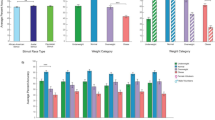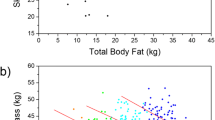Abstract
Fifteen participants were trained on a within-subjects basis with two discrimination training conditions and one simple generalization training (control) condition to determine whether gradient shifts can be obtained within a stimulus dimension consisting of women’s waist-to-hip ratios (WHRs). In one discrimination condition, the S− consisted of the “optimal” WHR; in the other, the S− consisted of the approximate mean WHR for adult women. For all three conditions, the S+ was an intermediate value. Under both discrimination training conditions, the generalization gradient was observed to shift away from the S− and toward extreme values on the opposite end of the dimension; under the control condition, the gradient was more closely centered on the S+. The results suggest that the processes involved in gradient shifts can affect judgments of biologically significant stimuli.
Similar content being viewed by others
References
BAERENDS, G. 1982. The herring gull and its egg. Part II. The responsiveness to egg-features. Behaviour, 82, 358–363.
BRAY, G. A. (1992). Pathophysiology of obesity. American Journal of Clinical Nutrition, 55, 488S−494S.
BUSS, D. M. (1987). Sex differences in human mate selection criteria: An evolutionary perspective. In C. Crawford, M. Smith, & D. Krebs (Eds.), Sociobiology and psychology: Ideas, issues and applications (pp. 335–351). Hillsdale, NJ: Erlbaum.
BUS, D. M. (1989). Sex differences in human mate preferences: Evolutionary hypothesis tested in 37 cultures. Behavioural and Brain Sciences, 12, 1–49.
CHENG, K., & SPETCH, M. (2002). Spatial generalization and peak shift in humans. Learning and Motivation, 330, 358–389.
CHENG, K., SPETCH, M. L., & JOHNSTON, M. (1997). Spatial peak shift and generalization in pigeons. Journal of Experimental Psychology: Animal Behavior Processes, 23, 469–481.
CHENG, K., SPETCH, M. L., KELY, D. M., & BINGMAN, V. P. (2006). Small-scale spatial cognition in pigeons. Behavioural Processes, 72, 115–127.
DERENE, A. (2006). Effects of S+, S− separation on gradient shifts in humans. Journal of General Psychology, 133, 163–173.
DERENE, A., & BREITSTEIN, R. M. (2006). Gradient shifts with naturally occurring human face stimuli. The Psychological Record, 56, 365–370.
DOBELSTEYN, C. J., JOFRES, M. R., MACLEAN, D. R., & FLOWERDEW, G. A. (2001). Comparative evaluation of waist circumference, waist-to-hip ratio, and body mass index as indicators of cardiovascular risk factors. The Canadian Heart Health Surveys. International Journal of Obesity and Related Metabolic Disorders, 25, 652–661.
FURNHAM, A., PETRIDES, K. V., & CONSTANTINIDES, A. (2005). The effects of body mass index and waist-to-hip ratio on ratings of female attractiveness, fecundity, and health. Personality and Individual Differences, 38, 1823–1834.
GALIZIO, M. (1985). Human peak shift: Analysis of the effects of threestimulus discrimination training. Learning and Motivation, 16, 478–494.
GAMBERALE, G., & TULLBERG, B. S. (1996). Evidence for peak-shift in predictor generalization among aposematic prey. Proceedings of the Royal Society of London B, Biological Sciences, 263, 1329–1334.
GAMBERALE-STILLE, G., & TULBERG, B. S. (1999). Experienced chicks show biased avoidance of stronger signals: An experiment with natural colour variation in live aposematic prey. Evolutionary Ecology, 13, 579–589.
GHIRLANDA, S., & ENQUIST, M. (1998). Artificial neural networks as models of stimulus control. Animal Behaviour, 56, 1383–1389.
GHIRLANDA, S., & ENQUIST, M. (1999). The geometry of stimulus control. Animal Behaviour, 58, 695–706.
GHIRLANDA, S., & ENQUIST, M. (2003). A century of generalization. Animal Behaviour, 66, 15–36.
HANSON, H. M. (1959). Effects of discrimination training on stimulus generalization. Journal of Experimental Psychology, 58, 321–334.
HENSS, R. (1995). Waist-to-hip ratio and attractiveness: Replication and extension. Personality and Individual Differences, 19, 479–488.
HONIG, W. K., & URCUIOLI, P. J. (1981). The legacy of Guttman and Kalish (1956): 25 years of research on stimulus generalization. Journal of the Experimental Analysis of Behavior, 36, 405–445.
JENKINS, H. M., & HARISON, R. H. (1960). Effects of discrimination training on auditory generalization. Journal of Experimental Psychology, 59, 246–253.
LAHTI-KOSKI, M., PIETINEN, P., MÄNNISTÖ, S., & VARTIAINEN, E. (2000). Trends in waist-to-hip ratio and its determinants in adults in Finland from 1987 to 1997. American Journal of Clinical Nutrition, 72, 1436–1444.
LEIMER, O., ENQUIST, M., & SILLÉN-TULBERG, B. (1986). Evolutionary stability of aposematic coloration and prey unprofitability: A theoretical analysis. American Naturalist, 128, 469–490.
LEVINE, M. P., & SMOLAK, L. (2006). The prevention of eating problems and eating disorders: Theory, research, and practice. Mahwah, NJ: Lawrence Erlbaum.
LEWIS, M. B., & JOHNSTON, R. A. (1999). Are caricatures special? Evidence of peak shift in face recognition. European Journal of Cognitive Psychology, 11, 105–117.
LISSNER, L., BJÖRKELUND, C., HEITMAN, B. L., LAPIDUS, L., BJÖRNTORP, P., & BENGTSON, C. (1998). Secular increases in waist-hip ratio among Swedish women. International Journal of Obesity, 22, 1116–1120.
MARLOWE, F., & WETSMAN, A. (2001). Preferred waist-to-hip ratio and ecology. Personality and Individual Differences, 30, 481–489.
McLAREN, I. P. L., BENET, C. H., GUTMAN-NAHIR, T., KIM, K., & MACKINTOSH, N. J. (1995). Prototype effects and peak shift in categorization. Journal of Experimental Psychology: Learning, Memory and Cognition, 21, 662–673.
McLAREN, I. P. L., & MACKINTOSH, N. J. (2002). Associative learning and elemental representation II: Generalization and discrimination. Animal Learning and Behavior, 30, 177–200.
O’DONELL, J., CROSBIE, J., WILLIAMS, D. C., & SAUNDERS, K. J. (2000). Stimulus control and generalization of point-loss punishment with humans. Journal of the Experimental Analysis of Behavior, 73, 261–274.
PRICE, G. M., UAUY, R., BREZE, E., BULPITT, C. J., & FLETCHER, A. E. (2006). Weight, shape, and mortality risk in older persons: Elevated waist-hip ratio, not high body mass index, is associated with a greater risk of death. American Journal of Clinical Nutrition, 84, 449–460.
RAMACHANDRAN, V. S., & HIRSTEIN, W. (1999). The science of art: A neurological theory of aesthetic experience. Journal of Consciousness Studies, 6, 15–51.
REXRODE, K. M., CAREY, V. J., HENEKENS, C. H., WALTERS, E. E., COLDITZ, G. A., STAMPFER, M. J., WILLETT, W. C., & MANSON, J. E. (1998). Abdominal adiposity and coronary heart disease in women. Journal of the American Medical Association, 280, 1843–1848.
RILLING, M. (1977). Stimulus control and inhibitory processes. In W. K. Honig & J. E. R. Staddon (Eds.), Handbook of operant behavior (pp. 432–480). Englewood Cliffs, NJ: Prentice Hall.
SEIDEL, J. C., PÉRUSSE, L., DESPRÉS, J.-P., & BOUCHARD, C. (2001). Waist and hip circumferences have independent and opposite effects on cardiovascular disease risk factors: The Quebec Family Study. American Journal of Clinical Nutrition, 74, 315–321.
SINGH, D. (1993). Adaptive significance of female physical attractiveness: Role of waist-to-hip ratio. Journal of Personality and Social Psychology, 65, 293–307.
SPETCH, M., CHENG, K., CLIFFORD, C. (2004). Peak shift but not range effects in recognition of faces. Learning and Motivation, 35, 221–241.
STADON, J. E. R. (1975). A note on the evolutionary significance of “supernormal” stimuli. The American Naturalist, 109, 541–545.
STREETER, S. A., & McBURNEY, D. H. (2003). Waist-hip ratio and attractiveness: New evidence and a critique of “a critical test.” Evolution and Human Behavior, 24, 88–98.
SYMONS, D. (1995). Beauty is in the adaptations of the beholder: The evolutionary psychology of human female attractiveness. In P. R. Abramson & S. D. Pinkerton (Eds.), Sexual nature, sexual culture (pp. 80–118). Chicago: University of Chicago Press.
THOMAS, D. R. (1993). A model for adaptation-level effects on stimulus generalization. Psychological Review, 100, 658–673.
THOMAS, D. R., WINDELL, B. T., WILLIAMS, J. L., & WHITE, K. G. (1985). Stimulus presentation frequency in brightness discrimination and generalization: A test of adaptation-level and signal detection interpretations. Perception & Psychophysics, 37, 243–248.
WAS, P., WALDENSTRÖM, U., RÖSSNER, S., & HELBERG, D. (1997). An android body fat distribution in females impairs the pregnancy rate of in-vitro fertilization-embryo transfer. Human Reproduction, 12, 2057–2060.
WEARY, D. M., GUILFORD, T. C., & WEISMAN, R. G. (1993). A product of discriminative learning may lead to female preferences for elaborate males. Evolution, 47, 333–336.
WEEDEN, J., & SABINI, J. (2005). Physical attractiveness and health in Western societies: A review. Psychological Bulletin, 131, 635–653.
WILLS, S., & MACKINTOSH, N. J. (1998). Peak shift on an artificial dimension. The Quarterly Journal of Experimental Psychology, 51B, 1–31.
YU, D. W., & SHEPARD, G. H. (1998). Is beauty in the eye of the beholder? Nature, 396, 321–322.
ZIMMER, R. (2003). Abstraction in art. Philosophical Transactions of the Royal Society of London B, Biological Sciences, 358, 1285–1291.
Author information
Authors and Affiliations
Corresponding author
Additional information
This material is based on work supported by the National Science Foundation under Grant No. 01322899. Thanks are extended to Brittany Bechthold, Karla Fehr, and Carmen Schanilec for assisting with data collection.
Rights and permissions
About this article
Cite this article
Derenne, A., Breitstein, R.M. & Cicha, R.J. Shifts in Postdiscrimination Gradients Within a Stimulus Dimension Based on Female Waist-to-Hip Ratios. Psychol Rec 58, 51–60 (2008). https://doi.org/10.1007/BF03395602
Published:
Issue Date:
DOI: https://doi.org/10.1007/BF03395602




